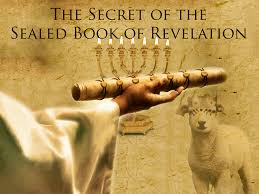
The same declaration is reiterated at the end of the book of Revelation in Chapter 22:6, “… and the Lord God of the holy prophets sent His angel to show his servants the things which must shortly take place”. And in verse 10, “… do not seal the words of the prophesy of this book, for the time is at hand”.
With such clear statements providing such a clear starting point, we may therefore expect to see fulfillment of these prophesies commence shortly after the Apostle John received the Revelation, just as it was declared; and making a survey of history shows just how the sequence of these prophesies correspond with the chronology of historical events.
To be clear, this is not the Preterists View, which presumes all the prophesies of antichrist have already been fulfilled, but this is the Historicist View, which aligns the sequence of prophesies with the progression of history in a continuation of fulfillment – unto the Millennial Reign of Christ. This is the way the Jews interpreted the prophesies of Daniel and others, and how the first New Testament believers had verified that Jesus of Nazareth is the fulfillment of messianic prophesy – by matching particular historical events of Jesus to the former prophetic predictions.
By the time of the Protestant Reformation in the sixteenth century, so much prophetic history had unfolded, and with the explosion of learning brought by the Reformation, a remarkable proliferation of brilliant theologians were able to highlight, more than ever before, so many fulfilled prophesies. The prophesies upon their fulfillment and continuing fulfillment, at this point in time, provided more clarity to more certain interpretations.
The Historicist view not only agrees with the way prophesy had always been interpreted until the 20th century, but also abides within the scriptural parameters of prophesy language. Therefore, in order to adequately interpret prophesy, one must acquaint themselves with both history and prophesy language. If not so acquainted with these, I strongly recommend an introductory lesson by reading Remembering the Lost Art & Science of Interpreting Prophesy Language and Prophetic History before continuing on with this.
Then let us proceed to interpret the Seven Seals by matching them to the most significant events most relevant to redemptive history in chronological order, starting from the beginning of the Church era in the latter half of the first century.
First off, the context of the Seven Seals comes out of a scene from heaven, seen by St. John (chap 4-5), where attention is raised concerning a scroll of God sealed with seven seals, and no one was found worthy to open the scroll and loose its seven seals except for Messiah. Chapter 6 then commences with the opening of the seven seals.
First Seal : The Conqueror
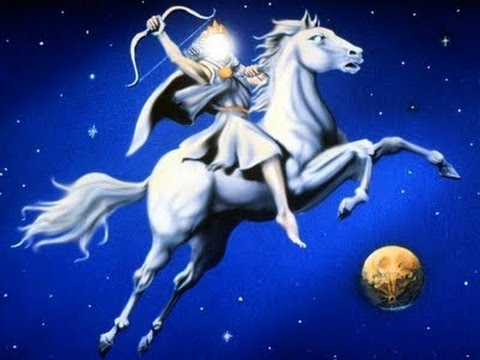
“And I looked, and behold, a white horse. He who sat on it had a bow; and a crown was given to him, and he went out conquering and to conquer.” ~ Rev 6:2
This oracle is brief and the rider of the white horse is not clearly identified in this passage alone, but the rider of the white horse is explicitly identified later in The Revelation as Jesus Christ in 19:11-16:
“Now I saw heaven opened, and behold, a white horse. And He who sat on him was called Faithful and True, and in righteousness He judges and makes war. His eyes were like a flame of fire, and on His head were many crowns. He had a name written that no one knew except Himself. He was clothed with a robe dipped in blood, and His name is called The Word of God.
And the armies in heaven, clothed in fine linen, white and clean, followed Him on white horses. Now out of His mouth goes a sharp sword, that with it He shall strike the nations. And He Himself will rule them with a rod of iron. He Himself treads the winepress of the fierceness and wrath of Almighty God. And He has on His robe and on His thigh a name written: KING OF KINGS AND LORD OF LORDS.”
The same kind of description of Messiah is also explained of St. John’s very first vision in the beginning of the Revelation.
“…His head and hair were like wool, as white as snow, and His eyes like a flame of fire; His feet were like fine brass, as refined in a furnace, and His voice as the sound of many waters; He had in His right hand seven stars, out of His mouth went a sharp double edged sword, and His countenance was like the sun shining in full strength…” ~ Rev 1:14-16
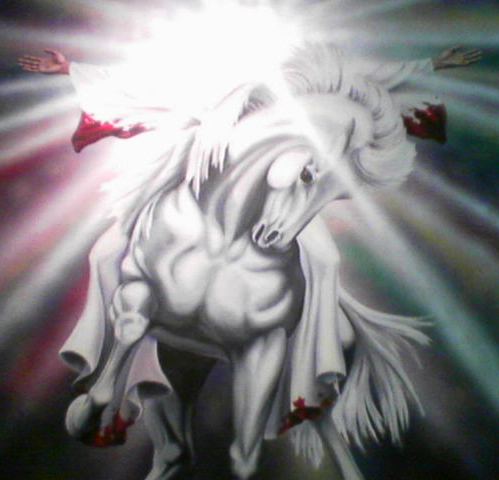
Notice the common denominators of all three passages such as the color white, which is an emblem of righteousness, and other details depicting a most triumphal warrior. a bow is a symbol for warrior (Jer 50:14, 29, 42, Lam 2:4, Psalm 46;9), and a crown, a symbol of supremacy – together, signifying a triumphant warrior-king. There are still many other oracles of Messiah portrayed with the same attributes among the prophets of old, such as Psalm 45 and Isaiah 11:4-5, which collectively give great support to the natural interpretation of the first seal. The crowned rider of the white horse is a most proper emblem of Jesus Christ, as His advance in conquering is a most proper emblem of His body of believers – And the armies in heaven, clothed in fine linen, white and clean, followed Him on white horses (Rev 19:14) – commissioned to reclaim the nations with the power of the Gospel.
Even before the great commission, during His ministry in the flesh, Jesus was already preparing to reclaim the nations when traveling abroad to Tyre and Sidon (Matt 15:21-28), and to the country of the Gergesenes, where He liberated those poor souls from the oppression of that legion of demons (Matt 8:28-33); And perhaps the most notable motion Jesus made began at the foot of Mount Hermon, in Caesarea Phillippi, the epicenter of pagan worship, a most spiritually dark territory often referred to as ‘Hell’s Gate’.
And there it was where Jesus announced Simon’s new name Peter, meaning rock, then declared, “…on this rock (that is that pagan rock of Hell’s Gate) I will build my Church, and the gates of hell shall not prevail against it.“ – because there would be a rock superior to that pagan alter, the Rock that is Christ, and the rock of faith, by which Peter and the rest of the Apostles, would conquer the world! ~ Ephesians 2:20 ~ Revelation 3:12
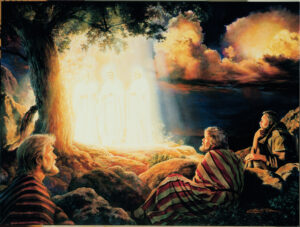
That motion continued a few days later when Jesus took Peter, James, and John up to the top of that same mountain, Mount Herrmon, where the rebellion of angels in the days of old made their covenant to take the daughters of men (Enoch 6 ~ Gen 6:1-4); And there it was where Jesus had transfigured Himself to His preeminent glory as way of announcing to the principalities, and powers, and rulers of the darkness of the age, and the spiritual host of wickedness in the heavenly places – that He has come to take back the nations!
And what do you know – just a few miles away, the city of Damascus, where persecuting Saul was converted to believing Paul, who was the initial-primary agent in building the church throughout the pagan world! Indeed Christ had conquered the power of death, sin and Satan, and His Church has perpetuated the same triumph! And not by violence, but by the power of the Gospel, they conquered him (Satan) by the blood of the Lamb, and by the word of their testimony, and not loving their lives to the death. ~ Rev 12:11
The event of Pentecost sent home thousands of newfound Christians from all over the world with the seed of the Gospel, which proliferated exponentially so that Christianity, right out of the gates, was taking the world by storm in a short period of time. This nonviolent yet highly controversial movement rapidly grew, even with the prospect of losing all they had in this world, including their lives. And though they would face death all day long, as St. Paul exclaims, “…in all these things we are more than conquerors through Him who loved us.” ~ Romans 8:37
So it is, the Spirit of prophesy had rendered an icon of a conquering warrior-king riding a white horse to represent the advance of Christ. The motion so expressed here, “…and he went out conquering and to conquer” – indicates the continuation of this motion, which would have great impact on the course of history. Such an event as the advance of Christianity qualifies more than any other event of this time as the best match for the prophesy of the first seal.
Other interpretations of the first seal included the white-horsed warrior king to be a pseudo-christ, as there were many false messiahs of that time, yet none who were so triumphant; Another interpretation worth considering has suggested the white horse rider to represent Roman Emperor Vespasian, who triumphed over the revolting Jewish nation. The destruction of Jerusalem & the temple, and eventual Roman subjugation of the Jews was certainly a monumental event which changed the course of history for mostly the Jews, but still not as significant as the outset of Christianity which changed the course of history for the entire world.
The initial advancement of the Christian movement perfectly corresponds with this prophesy commencing its fulfillment from the latter half of the first century, and is the premise for the next sequence of prophesies which corresponds with the next chain of events.
Second Seal: Conflict
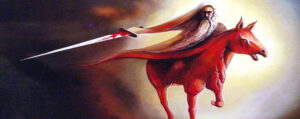
“Another horse, fiery red, went out. And it was granted to the one who sat on it to take peace from the earth, and that people should kill one another; and there was given to him a great sword” ~ Rev 6:4
This prophesy speaks of God’s judgment upon the two main persecuting powers against the early Church – the Jews and the Romans. Both groups, while severely persecuting God’s faithful followers, were being severely judged by divine providence, which ordained such conflict between the two persecuting powers, that many bloody wars ensued between the Jews and the Romans. Thus God had judged the two common enemies of Christianity by causing them to kill each other by their own swords.
The tension of this conflict was already building before and during the time of Jesus Christ, as indicated in the Gospel accounts. The Jews were not happy to be under the yoke of Rome so their expectation of Messiah coming to liberate them and establish Israel as a sovereign nation was their greatest aspiration. Such expectation led to their deep disappointment when realizing Jesus was not going to act as a military leader like the Judges of old.
First century Jewish historian Josephus covers the continuing buildup of tension between the Jews and Rome with many bloody rebellions which led to the destruction of Jerusalem in 70 A.D. under the rein of Vespasian, whereby over a million Jews were slaughtered. Yet that was not the end of the bloody wars between the Romans and the Jews, which continued on for another half a century.
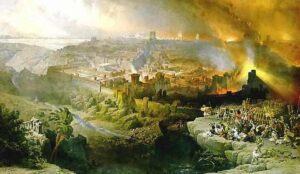
These bloody conflicts always ended with the Jews being subdued by the Romans, but not without great loss of Roman lives. One notable rebellion, during the reign of Emperor Hadrian, was the Bar Kokhba Revolt. Led by a man who claimed to be the Messiah, called Bar Kockhba (Son of the Star), the whole nation of Israel came against Rome, causing great mayhem for some time. Eventually the rebellion was crushed, but not without massive bloodshed on both sides.
Eusebius describes this history, “…that the doctrine and church of our Savior daily increased; but the calamities of the Jews were aggravated with new miseries.” So it was, even though God permitted such severe persecution from both Jews and Rome, Divine Providence had turned their swords on each other. The rider on a fiery red horse, who was given a great sword – is an expressive emblem of God’s poetic justice upon those two persecuting powers.
Third Seal: Scarcity
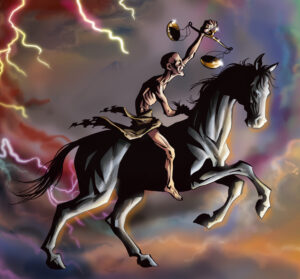
“I looked, and behold, a black horse, and he who sat on it had a pair of scales in his hand. And I heard a voice in the midst of the four living creatures saying, “A quart of wheat for a denarius, and three quarts of barley for a denarius; and do not harm the oil and the wine.”
~ Rev 6:5-6
The condition expressed in this third seal, communicates times of scarcity and famine. Certainly there were many hard times of scarcity & famine throughout the first few centuries, so different commentators have assigned different times to this prophesy. Learned men like Moses Lowman assign this oracle to the scarcity under the reign of the Antonine Family from 138 to 193 A.D. – while others assign it to events such as the Crisis of the Third Century.
However, I think it more reasonable to assign all of them to the oracle – since that is what Christ did when speaking of these beginning events of prophesy in Matthew 24:7, when saying there will be famines – that is not one famine but many. Such would be one of the conditions characterizing this sequence of beginning events which pertain to the first four seals of the Revelation. History shows indeed that there were multiple times of scarcity, among other harsh conditions, which thoroughly fulfilled the words of our Lord, as well as the oracle of the third seal.
The emblem of the black horse accompanied with a pair of scales, indicating the measurement of precise rations during times of scarcity & famine – projects a distinguishing condition of these times under the Roman Empire in which the Church was being brutally persecuted. This was another retribution of God’s justice, as justice is also represented by scales.
Fourth Seal – Sword, Famine, Plague, and Beasts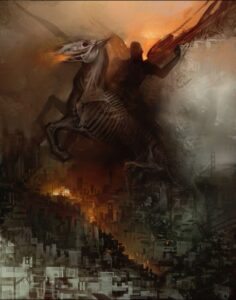
“So I looked, and behold, a pale horse; And the name of him who sat on it was Death, and Hades followed with him; And power was given to them over a fourth of the earth, to kill with sword, with hunger, with death, and by the beasts of the earth.” ~ Rev 6:8
The fourth seal expresses additional calamities of God’s justice upon the Roman world, which persisted in persecuting His growing church. Besides the continuation of the sword & famine, the added element is plague and beasts. In those days, the word ‘death’ was often used to signify ‘plague’, and since it would be redundant to literally say, “to kill with…death…” – it is safe to conclude that ‘plague’ was the intended meaning. Furthermore, plague naturally follows war and famine in the same order listed in the oracle.
What follows lastly, is the element of wild beasts taking advantage of a weakened society to devour. The oracle of Ezekiel 33:27 describes the same elements of the sword, plague, and beasts as an inescapable divine judgement – “…those who are in the ruins shall fall by the sword, and those who are in the open field I will give to the beasts to be devoured, and those who are in the strongholds and caves shall die of pestilence”
A period of extreme chaos within the Roman Empire started around 220 A.D. to about the end of the century, known as The Crisis of the Third Century. Looking at the Roman Emperor Timeline shows that Emperors did not usually last long during that time, since there was a multitude of intrigues and civil conflicts which caused great instability. In the space of just 50 years there were over 20 emperors, most of whom died a violent death, not counting the 30 who pretended to the throne.
Such internal weakness gave great opportunity for the Persians, Scythians, and northern nations to wreak havoc on Roman lands. The figurative meaning of beasts, signifying kingdoms, which devour societies, may also be what the oracle is alluding to. As waves of widespread bloodshed made way for widespread famine, the climate was then set for multiple waves of ravaging pestilence, spreading far & wide. Adding to this was unseasonable weather causing crop failures.
This history of such massive calamities is very well documented by men like Eutropius, Zonarus, Eusebius, Dyonisius and many others who testify that from the devastation of war & famine – pestilence became the most remarkable element of the times. So abundant are the astonishing descriptions of these times that it’s difficult to only quote a few:
Lipsius speaks of the plague during the reign of Gallus, declaring that he never read of any greater plague for the space of time that it lasted, or of the land that it overspread. Trebellius Pollio reports of the next wave of pestilence, during the reign of Gallienus, that five thousand men perished in a single day. Of that same time, Zosimus states, “…such a grievous pestilence as never happened at any time before, rendered the calamities inflicted by the barbarians more moderate.” Still afterwards, Zosimus informs us of the next plague which swept through – claiming the lives of many soldiers of Rome and their rivals, including Emperor Claudius II.
Joseph Mede highlights the writings of Cyprian and Dionysius of Alexandria, who both expressed how the calamities of that time were divine judgements of former predictions. Hence, the rider of the pale horse, with hell following after, deems a prime illustration of the fourth seal.
Let us also reflect that while Roman society was entertained watching Christians being slaughtered by the sword of gladiators and ripped apart by the jaws & claws of lions and other beasts, so was God turning on them the same sorrows. Thus, the first four seals are perfectly summed up by Jesus – as the beginning of sorrows.
“…And you will hear of wars and rumors of wars. See that you are not troubled; for all these things must come to pass, but the end is not yet. For nation will rise against nation, and kingdom against kingdom. And there will be famines, pestilences, earthquakes in various places. All these things are the beginning of sorrows.” ~ Matt 24:6-8
Fifth Seal: Cry of the Martyrs
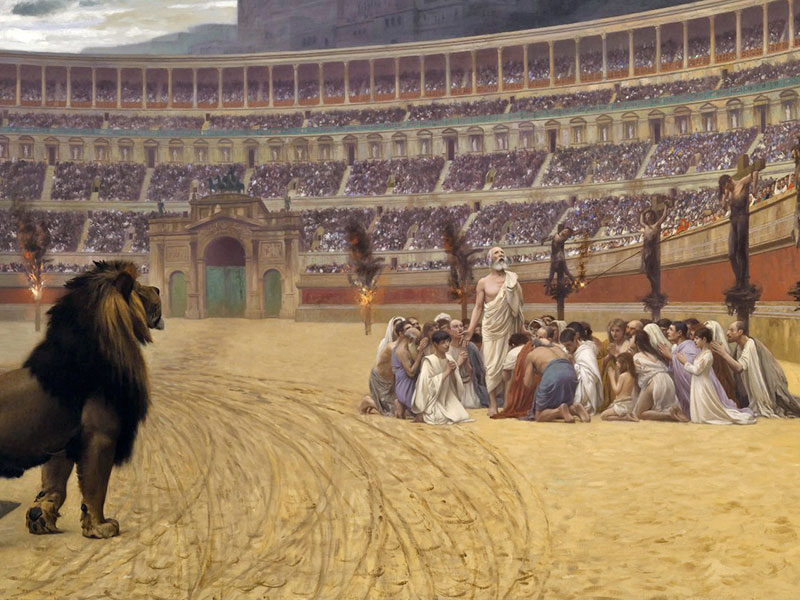 “When he opened the fifth seal, I saw under the alter the souls of those who had been slain for the word of God and for the testimony which they held. And they cried with a loud voice, saying, “How long, O Lord, holy and true, until You judge and avenge our blood on those who dwell on the earth?” Then a white robe was given to each of them; and it was said to them that they should rest a little while longer, until both the number of their fellow servants and their brethren, who would be killed as they were, was completed.” ~ Rev 6:9-11
“When he opened the fifth seal, I saw under the alter the souls of those who had been slain for the word of God and for the testimony which they held. And they cried with a loud voice, saying, “How long, O Lord, holy and true, until You judge and avenge our blood on those who dwell on the earth?” Then a white robe was given to each of them; and it was said to them that they should rest a little while longer, until both the number of their fellow servants and their brethren, who would be killed as they were, was completed.” ~ Rev 6:9-11
Different from the other seals, yet very much related, we see a glimpse into the spirit realm where the martyrs wait in anticipation for God’s righteous judgment to overthrow the persecuting power of the Roman world. For their faithfulness unto death, they are given white robes, signifying God’s covering of righteousness, then reassured of the pending retribution.
This oracle is the premise of the next seal, which in due season, would complete the divine judgments upon Pagan Rome by shaking it to its very foundation and overthrowing its head.
Sixth Seal: Toppling a Kingdom
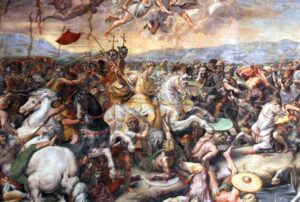
“I looked when he opened the sixth seal, and behold, there was a great earthquake; and the sun became black as sackcloth of hair, and the moon became like blood. And the stars of heaven fell to the earth, as a fig tree drops its late figs when it is shaken by a mighty wind. Then the sky receded like a scroll when it is rolled up, and every mountain and island was moved out of its place.
The kings of the earth, the great men, the rich men, the commanders, the mighty men, every slave and every free man, hid themselves in the caves and in the rocks of the mountains, and said to the rocks and the mountains, “Fall on us and hide us from the face of Him who sits on the throne and from the wrath of the Lamb! For the great day of His wrath has come, and who is able to stand?” ~ Rev 6:12-17
The imagery here illustrates a cataclysmic event of epic proportions of the earth and universe collapsing. Many readers not familiar with the style of prophesy language have not known what to make of such an oracle, and have been led astray by either interpreting it literally or inventing sketchy conjectures.
However, there is already a precedent of prophetic patterns which may guide us through a prophesy such as this sixth seal. The same genre of ‘cosmic cataclysm’ had already been established by the Spirit of prophesy, to illustrate the downfall of a great empire, as governed by divine providence. Such a design of cosmic imagery was a rather typical motif among the prophets of Israel in foretelling the pending doom of worldly kingdoms in opposition to the Kingdom of God. One example from Isaiah 34:4 uses this illustrative style to declare a general judgment of the world empires:
“All the stars of heaven shall be dissolved, and the heavens shall be rolled up like a scroll; All their stars shall fall down as the leaf falls from the vine, and as fruit falling from a fig tree.”
The same style of cosmic imagery was projected to announce the destruction of Egypt in Ezekiel 32:7-8:
“When I put out your light, I will cover the heavens and make its stars dark; I will cover the sun with a cloud, and the moon shall not give her light. All the bright lights of the heavens I will make dark over you, and bring darkness upon your land, says the LORD God.”
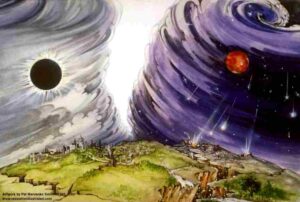
And the same genre used in the declaration of Babylon’s impending doom in Isaiah 13:10
“For the stars of heaven and their constellations will not give their light; The sun will be darkened in its going forth, and the moon will not cause its light to shine”
Still others like Joel 2:10 – concerning the judgment of Jerusalem, and the words of our Lord in Matt 24:29. All these have collectively established a prophetic pattern, as this particular genre of ‘cosmic cataclysm’ always signifies the overthrow of a great kingdom.
With such a precedent, we can be certain that the same imagery used in the oracle of the sixth seal is signaling the downfall of another kingdom. And allowing that oracle to continue the same sequence along the chronology of history brings us to the fall of Pagan Rome.
In order to properly convey this most significant event, I must frame it with some context:
The Roman Emperor, Diocletian, from 384-305, was credited for stabilizing the empire from The Crisis of the Third Century. He partitioned the empire in two and appointed Maximian as co-emperor to reign over the Western Empire while Diocletian reigned over the Eastern Empire. Midway through his reign, Diocletian appointed two other co-emperors of lower rank, Galerius and Constantius, each with the title Caesar. Thus, the empire was then divided into quarters, to be ruled by each of the four emperors, known as the Techtrarchy. Such delegation of power facilitated the re-stabilization of the Roman Empire.
However, these emperors were tyrants of the worst kind (except Constantius); Their excessive ambition, greed, and lust had so grievously suppressed & molested the people that a whole new crisis developed into a condition perhaps worse than before. Moreover, another persecution against the Christians was launched, more appalling and persistent than those prior, lasting over ten years. Though Diocletian & Maximian retired after a 20 year reign, their successors perpetuated the persecution and carried on the same tyranny against their own people. Yet the providence of God saw to it that one particular succession would turn the tables.
Upon the death of Constantius in 306 A.D., the succession of his son Constantine was contested by other imperial heads such as Maxentius & Galerius in the west, and Maximinus & Licinius in the east, all vying for dominance in bloody civil wars. Amidst such chaos, divine providence finally confronted the tyrannical descendants of Diocletian in the most remarkable way that even unbelievers recognized it to be divine retribution. Such a striking chain of events was documented by both Lactantius and Eusebius of that day:
Though Maximian had retired, he again took the title Augustus to support his son Maxentius to usurp the seat of Rome. In early 310, Maximian made a failed attempt to seize Constatine’s title; then later that year was caught red-handed in an assassination attempt against Constantine, then forced by Constantine to hang himself. Maximian’s son, Maxentius, alligned with Galerius, perpetuated the same opposition against Constantine while cruelly oppressing his own people in Italy. Though Maxentius had a fighting force twice the size of Constantine’s force, Constantine had realized a decisive victory in the Battle of the Milvian Bridge in 312, which resulted in Maxentius drowning in the Tiber River while being pummeled by his own troops in retreat.
During these conflicts, Emperor Galerius, who’s insane cruelty was more excessive than his fellow tyrants, was struck with a severe malignant condition in his bowels, which spiraled into excruciating torments from his putrefied & worm laden intestines, as the foul stench carried throughout the whole city. Such intolerable anguish often drove him to attempt suicide, and kill some of his physicians who could not cure him. In his misery, he thought of the Christians and put an end to their persecutions by a public edict while petitioning their prayers for healing, though he died soon after. Other instances of intestinal afflictions from God’s wrath are recorded in 2 Chron 21:12-15, 18-19, and Acts 12:23.
At this point, Diocletian, in his retirement, suffered his own torture – to see every vestige of his legacy dwindle into disgrace and then to extinction, spent the remainder of his pitiful existence in torment and despair.
Still, there was Maximinus Daia, maternal nephew & adopted son of Galerius, who was reigning over the Eastern Empire with even greater cruelty than his predecessors; With his own signature of unbridled lust, so excessive & forceful, that not a single matron or virgin of beauty & virtue was withheld from his insatiable lust. He also was due for divine retribution by the time Licinius (co-emperor with Constantine) advanced his forces against him; Maximinus’ forces were then obliterated as he fled like a coward in disguise, making his way to Tarsus, where he elected to commit suicide. However, the poison did not kill him, but gave him a horribly gruesome disease, as Lactantius recounts,
“…the poison began to rage, and to burn up everything within him, so that he was driven to distraction with the intolerable pain; and during a fit of frenzy, which lasted four days, he gathered handfuls of earth, and greedily devoured it. Having undergone various and excruciating torments, he dashed his forehead against the wall, and his eyes started out of their sockets. And now, become blind, he imagined that he saw God, with His servants arrayed in white robes, sitting in judgment on him. He roared out as men on the rack are wont, and exclaimed that not he, but others, were guilty. In the end, as if he had been racked into confession, he acknowledged his own guilt, and lamentably implored Christ to have mercy upon him. Then, amidst groans, like those of one burnt alive, did he breathe out his guilty soul in the most horrible kind of death.”
Triumphant Emperor Licinius, not content sharing power with Constantine, conspired to usurp the empire for himself alone, became deranged with such ambition that his character digressed into the same cruel tyrant & persecutor of Christ as those he witnessed being crushed by the wrath of God before him. Waging a series of battles against Constantine, he was ultimately defeated and killed, but not before confessing his guilt and granting official toleration to the Christians.
Preeminent ones like emperors & priests were often likened to stars, so the prophetic imagery of the stars being darkened and falling from the sky are expressive illustrations of these wicked powers being snuffed out and thrown down. Also, their pagan gods were personified in the sun, moon, and stars, which were also casts down as the pagan religion was abolished, temples demolished, priests banished; thus all the pagan lights were taken out.
Customary with such metaphorical renderings, the same prophesy would be accompanied with a plain rendering, each representation serving to reinforce & clarify the message. Accordingly, this sixth seal begins with a metaphorical rendering, which we have focused so far, but the second part has a plain rendering:
“The kings of the earth, the great men, the rich men, the commanders, the mighty men, every slave and every free man, hid themselves in the caves and in the rocks of the mountains, and said to the rocks and the mountains, “Fall on us and hide us from the face of Him who sits on the throne and from the wrath of the Lamb! For the great day of His wrath has come, and who is able to stand?”
The same way of describing the terror of their demise has been used in Hosea 10:8: “They shall say to the mountains, “Cover us!” and to the hills. “Fall on us!” Jesus quotes that exact expression in Luke 23:30, to assure His faithful of the reality of divine retribution.
And Isaiah 2:19: “They shall go into the holes of the rocks, and into the caves of the earth, from the terror of the LORD and the glory of His majesty, when He arises to shake the earth mightily.” Also notice this revolutionary event of Isaiah as well as this sixth seal is illustrated with an earthquake – we will touch more on that later.
As for those kings of the earth, the great men, the rich men, the commanders, the mighty men, every slave and every free man – the sixth seal of John’s Revelation renders this same picture for the Roman tyrants of Constantine’s time: Diocletian, Maximian, Galerius, Maxentius, Maximinus, Lucinius – who were so crushed along with all their governors & commanders, as well as all their posterity and adherents alike – being so overwhelmed by the terror of their destruction that such description is quite fitting.
Constantine triumphs as the sole emperor of the whole empire, transfers the capital from Rome to Constantinople, sets up a new model for the Roman government & empire, abolishes paganism, and legalizes Christianity. This was a most profound revolution which supplanted the pagan powers with the Christian religion, sending pagans on the run while Christians came out of hiding to publicly profess & practice their faith.
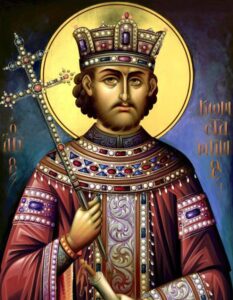
Many historians throughout the centuries have debated whether or not Constantine had truly converted to the Christian faith or just realized its political usefulness. Either way, He and his continuing dynasty put an end to the persecutions against Christians and turned the tides against the pagans. This brought a time of peace and protection for not only the Christians but the empire in general; and we may certainly attribute this relief to the providential care of our Lord.
Yet Constantine has too often been given too much credit for this triumph, or too much blame for the apostasy which followed. Each school of thought takes an extreme – from heralding him as a super-saint – to projecting him as an impostor of the Christian faith. A moderate view acknowledges a fallible man who came into the Faith to do great things, yet also transgressed. Even those who insist Constantine was a wicked impostor from the start must acknowledge the many times God raised-up and empowered wicked nations like Babylon & Assyria to carry out His rod of retribution. It seems to me that Constantine’s life resembles the pattern of King Solomon, who was used by God to do great things, yet fell into idolatry later in his life (1 Kings 11).
The sixth seal continues with an expanded description of this time in chap 7:
“After these things I saw four angels standing at the four corners of the earth, holding the winds, that the wind should not blow on the earth, on the sea, or on any tree.” ~ Rev 7:1
This style of prophetic description illustrates a time of peace, whereby the winds of war had relented from the previous commotions. The earth and the sea are prophetic emblems of the nations, as the trees and the grass are emblems of the inhabitants, which we will look at in the later oracles.
Lactantius, of that time, rejoiced in this happy state, and recognized this fulfillment of prophesy while alluding to this oracle, “Tranquility being restored throughout the world, the church which was lately ruined rises again. Now after the violent agitations of so great a tempest, a calm air and the desired light become resplendent. Now God has relieved the afflicted. Now He has wiped away the tears of the sorrowful.” The detail of God giving relief and wiping away their tears is coming up in verse 16-17.
“Then I saw another angel ascending from the east, having the seal of the living God. And cried with a loud voice, “Do not harm the earth, the sea, or the trees till we have sealed the servants of our God on their foreheads.” ~ Rev 7:2-3
This was a time in which multitudes of people, from not only the Roman Empire, but even surrounding nations, embraced the Christian faith, as many were genuinely baptized. Surely the sole focus of this part of the prophesy is the celebration of that glorious exaltation of God’s Church, which then opens up with a view of the heavenly scene:
And I heard a number of those who were sealed. One hundred and forty-four thousand of all the tribes of Israel… ~ Rev 7:4-8
The next verses list twelve thousand from each of the twelve tribes of Israel starting with the messianic line of Judah. It is appropriate that the body of spiritual Israel is first projected since they are the first chosen people of God from whom the Messiah and His New Testament People were brought forth.
“After these things I looked, and behold, a great multitude which no one could number, of all the nations, tribes, peoples, and tongues, standing before the throne and before the Lamb, clothed with white robes, with palm branches in their hands, and crying out with a loud voice, saying, “Salvation belongs to our God who sits on the throne, and to the Lamb!” All the angels stood around the throne and the elders and the four living creatures, and fell on their faces before the throne and worshiped God, declaring:
“Amen! Blessing and glory and wisdom, thanksgiving and honor and power and might, be to our God forever and ever! Amen.”
Then one of the elders answered, saying to me, “Who are these arrayed in white robes, and where did they come from?”
And I said to him, “Sir, you know.”
So he said to me, “These are the ones who came out of the great tribulation, and washed their robes and made them white in the blood of the Lamb. Therefore they are before the throne of God, and serve Him day and night in His temple. And He who sits on the throne will dwell among them. They shall neither hunger anymore nor thirst anymore; the sun shall not strike them, nor any heat; for the Lamb who is in the midst of the throne will shepherd them and lead them to living fountains of waters. And God will wipe away every tear from their eyes.” ~ Rev 7:9-17
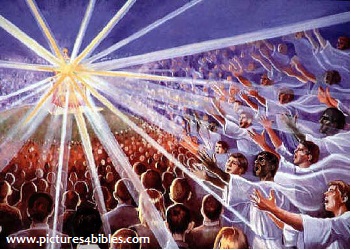
This heavenly exultation, as highlighted by Lactantius of that time, focuses solely on the glorious triumph of Christ over His pagan enemies, which subsequently gives rest to His faithful (sealed) in heaven forever; And rest to his faithful upon the earth for a season. This revelation serves to encourage those on earth to remain steadfast through the next episode of tribulation.
Such peace and prosperity on earth tends to give way to complacency and corruption in a world in which complete redemption is still pending. The prior persecutions made it so Christian’s had everything on earth to lose, including their lives, so only those with the utmost conviction were joining the ranks of God’s kingdom at first; But once Christianity was exalted to a high social status, adherents to the Christian religion had much more in this world to gain, as Christianity then started to become a type of bandwagon movement full of nominal believers and false converts. And this is the premise of the seventh seal.
Seventh Seal: Prelude to the Seven Trumpets
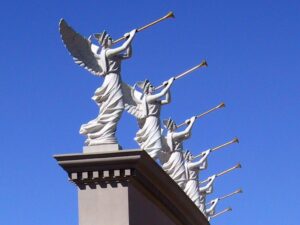
“When He opened the seventh seal, there was silence in heaven for about half an hour. And I saw the seven angels who stand before God, and to them were given seven trumpets. Then another angel, having a golden censer, came and stood at the alter. He was given much incense, that he should offer it with the prayers of the saints upon the golden alter which was before the throne. And the smoke of the incense, with the prayers of the saints, ascended before God from the angel’s hand.” ~ Rev 8:1-4
The opening of the seventh seal causes a significant silence, which draws attention to what’s coming. This scene describes the heavenly temple by which the Hebrew temple worship had been designed. The offering of incense & prayers at the alter represents the safety of God’s redemption, but what happens next is very surprising:
“Then the angel took the censor, filled it with fire from the alter, and threw it to the earth. And there were noises, thunderings, lightnings, and an earthquake.” ~ Rev 8:5
There, from the very place of safety, came the wrath of God! Shocking as this may be, it is yet a just reaction to the multitude of nominal believers and false converts, who were bearing the name of the LORD in vain, and using that place of safety and refuge as a means for worldly gain and corrupt schemes.
So the seven angel’s who had the seven trumpets prepared themselves to sound. ~ Rev 8:6
Hence, the seventh seal bears forth the next episode of divine retribution thrusted forth in a series of seven trumpets. This concludes our study of The Seven Seals and brings us to the next study of The Seven Trumpets.
Main Sources
– Word & Spirit of God, Who Was and Is and Is to come
– Flavius Josephus – ‘Wars of the Jews‘
– The Apostolic Fathers – “The Researchers Library of Ancient Texts Volume 2”
– Lactantius – “The Manner in which the Persecutors Died” or alternate text
– Eusebius Pamphilus – “Ecclesiastical History“
– The Apocrypha – 1 Maccabees & 2 Maccabees
– Moses Lowman – “Paraphrases and Notes on the Revelation of St. John“
– John Clark Ridpath – ‘Ridpath’s Universal History’
– Charles Daubuz – “A Perpetual Commentary on the Revelation of St. John“
– E H Broadbent – “The Pilgrim Church”
– Joseph Benson – “Benson’s Commentary on Revelation“
– Thomas Newton – “Dissertations of the Prophesies” – Volumes 1-3
– Albert Barnes – “Barnes’ Notes on the Entire Bible
– Adam Clark – “Clark’s Commentary on the Bible“
– John Foxe – ‘Foxes Book of Martyrs’
– John Gill – “Gill’s Exposition of the Bible“
– Kenneth Scott Latourette – ‘A History of Christianity’

